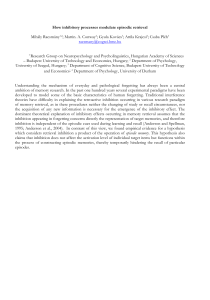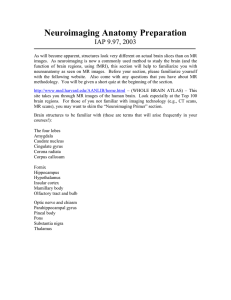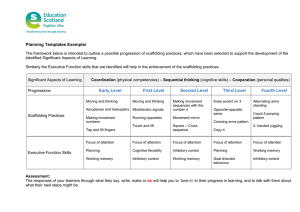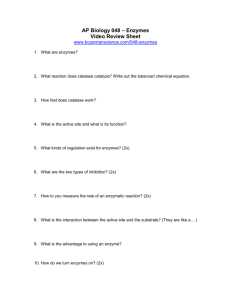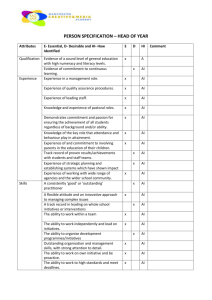Pharmacological modulation of response – target identification using fMRI inhibition Mitul Mehta
advertisement
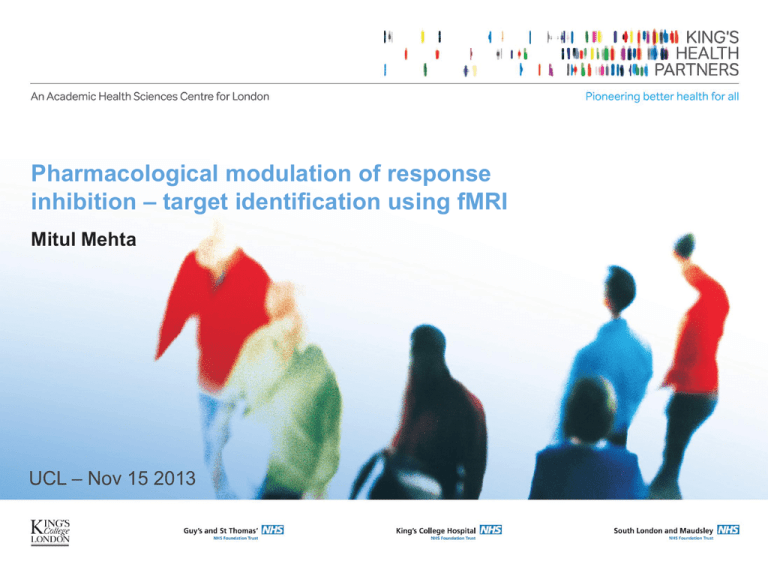
Pharmacological modulation of response inhibition – target identification using fMRI Mitul Mehta UCL – Nov 15 2013 Imaging at Denmark Hill Maurice Wohl Clinical Neuroscience Institute Clinical Research Facility C.N.S. Maudsley Hospital Institute of Psychiatry James Black Centre St. Thomas’ PET Centre Response inhibition Page 2 The ability to inhibit a motor response Or the ability to not respond in a task appropriate manner A key component of cognitive control Impaired in many psychiatric conditions, neurological disorders and following brain injury Measuring response inhibition GO/NO-GO Design STOP SIGNAL Page 3 Inhibitory performance e.g., Aron et al. (2006) e.g., Konishi et al. (1999) percent of responses to no-go stimuli The stop signal task Page 5 + Page 6 Page 7 + Page 8 Page 9 + Page 10 Page 11 + Page 12 Page 13 + Page 14 Page 15 + Page 16 Page 17 Page 18 + Page 19 Page 20 Stop signals are required to be: + + Thanks to P Boulinguez for the horse pic! • Unpredictable • (Infrequent) • Able to trigger a process independent of the go signal Meta-analysis of stop signal tasks Rae et al. (2013) Neuroimage in press Page 21 Problem #1 If stop signals are infrequent they will be salient, attention grabbing and arousing To what extent are brain activations to the stop signal due to response cancellation? Sharp et al. (2010) PNAS Page 22 IFG – stop AND continue SMA – STOP AND slow Sharp et al. 2010 PNAS Page 24 Identical stop signal tasks Different instructions Inhibit – cancel response Target detect – count no of up arrows Sharp et al. 2010 PNAS Page 26 • 16 healthy volunteers • 40mg methylphenidate or placebo • Double blind crossover Go signal Stop trials 20% Time Continue trials 20% • Hypotheses: The effect of methylphenidate on right IFG activation would be associated with attentional capture, and would hence be observed during both successful inhibition and attentional capture trials methylphenidate will modulate performance-monitoring networks during failed inhibition Pauls et al. (2012) Biological Psychiatry Overview of mechanism of action of stimulant treatments Methylphenidate / amphetamine The effects of methylphenidate on IFG activity STOP versus GO Reductions on methylphenidate 1 2 Pauls et al. (2012) Biological Psychiatry Regions modulated show different connectivity Continue vs go 2 Go signal Stop trials 20% Page 29 Stop vs go 1 Time Continue trials 20% 1 2 Pauls et al. (2012) Biological Psychiatry What happens during errors? Pauls et al. 2012 Biol Psych; Hester et al. 2012 J Neurosci Page 30 Neuroimaging studies of ATX (published) • Also increased activation in right IFG during failed + successful response inhibition trials (Chamberlain et al, 2009) • ATX increases activity in bilateral IFG and SMA (Graf et al. 2011) Chamberlain et al. (2009) Biol Psychiatry Response inhibition & drug effects • Stop signal tasks require multiple processes for success and these can be separated along lines of stimulus capture and outright inhibition (at least) • Effects of methylphenidate reveal the IFG role to be complex and multifactorial • Additional roles of other brain regions (e.g. putamen) may be related to other aspect of inhibitory tasks • The concepts of behavioural inhibition as measures by SSRT are insufficiently precise in earlier studies and our findings suggest that a reappraisal of deficits and treatment effects in ADHD is warranted Page 32 Go / nogo Page 33 Effects of methylphenidate during a go/no-go task Costa et al. (2013) Cereb Cortex Page 34 Varieties of go/no-go Page 35 Page 36 GO/NO-GO The STANDARD MODEL The ALTERNATIVE MODEL PROACTIVE REACTIVE PROACTIVE INHIBITORY CONTROL How to do to get this true unbiased control condition? 180 Go Go control Number of trials NoGo Go control Go 20 0.5 1 Normalized Reaction Time The proactive inhibition model Proactive Inhibition External Stimulus Motor Output Trigger Automatic Motor Activation Identification Internal Control Impulse activation inhibition default state Internal Stimulus Volitional Response Preparation Noradrenergic modulation See Robbins and Arnsten for recent review. Annual Review of Neuroscience (2013) Does NA manipulation modulate the activity of the proactive network? Region BA Side p(FWE- k corrected) Putamen Insula 48 48 R R 0,020 61 Cerebellum Middle occipital gyrus Middle occipital gyrus SMA Posterior temporal lobe Superior parietal gyrus Superior parietal gyrus Middle occipital gyrus Inferior occipital gyrus Middle occipital gyrus Superior occipital gyrus Superior parietal gyrus Superior occipital gyrus PCC PCC ACC Superior frontal gyrus Thalamus * Putamen 19 19 39 6 L R R L 0,000 1719 0,035 53 21 * * 19 19 37 19 7 * 23 23 32 32 * * * L L L L L L L L L L R R R L L L 0,000 369 0,001 114 0,000 295 0,027 57 0,055 47 0,001 108 zscore 4,76 4,01 x y z 24 36 9 12 -12 0 4,58 4,56 4,44 4,44 -18 45 39 -9 -66 -78 -72 6 -24 6 18 54 4,34 4,33 4,20 4,19 4,01 3,59 4,12 4,08 3,81 4,11 3,25 3,93 3,67 3,90 3,84 3,75 -42 -18 -15 -51 -45 -42 -21 -27 -24 -6 6 12 18 -9 -12 -24 -48 -45 -51 -78 -75 -72 -81 -57 -93 -15 -6 42 45 -6 -3 6 6 33 27 3 -3 12 45 51 27 39 42 12 18 12 3 -6 Clonidine Stop signal and preparatory inhibition Hu and Li (2012) HBM Page 41 Page 42 Warm colours show preparatory activity for successful inhibition Areas include midline frontal and parietal structures and lateral frontal areas A proactive inhibition model A general, early, elementary and nonselective inhibitory mechanism supported by the SMC is involved in response control when the situation is unpredictable. STIMULUS Executive setting Automatic motor activations Response Automatic inhibition time Summary Successful inhibition involves elemental of - executive setting (proactive) - attentional capture (saliency) - action cancellation (reactive) AND their links Few studies have attempted to parcellate in patients their impairments in inhibitory behaviour Amelioration strategies must take into account the precise nature of inhibitory deficit and use tasks sensitive to these features Neuroimaging studies are beginning to combine psychopharmacology and novel inhibitory control tasks Page 44 Thanks Phillipe Boulinguez – for sharing data on unpublished clonidine study and some slides on proactive inhibition MRC, IoP – for funding Astrid Pauls and Owen O’Daly – for their work on the MPH study David Sharp and team – for development of the attentional capture version of SST Page 45 Page 46 Psychological models Neuroimaging methods Molecular investigations Clinical issues Why is it so tricky? The psychological model that has thus far guided studies on the neural and neurochemical bases of inhibitory control is likely incomplete, or even invalid in some instances. Neuroimaging methods are constrained by the psychological model, and by the compromises that have to be found between spatial and temporal resolution. Current methods do not allow tracking the activity of all neurotransmitters systems. Clinical issues Proactive inhibition: A gate to the understanding of executive disorders in various neurological and psychiatric conditions? bis Open up new horizons regarding the pharmacotherapeutic strategies for various diseases associated with inhibitory disorders? Psychological models Neuroimaging methods Molecular investigations WHAT TO LOOK FOR? (with fMRI) Clinical issues Reactive activity Proactive activity Tonic activity - implements the inhibitory Non-selective (context-dependent) set, STIM - modulates the prestimulus activity of the motor brake circuitry - involves essentially a medial fronto-parietal network Evoked (phasic) activity -is not specifically triggered by Selective (No-Go) no-go signals Non-selective (context-dependent) - is rather automatic and nonSTIM selective - depends on the context (inhibitory set) - is limited to SMA Psychological models Neuroimaging methods Molecular investigations Clinical issues Proactive inhibitory control dysfunctions: Issues and questions for future research Proactive Inhibitory Control arouses growing interest in the field e.g., Aron (2011) From Reactive to Proactive and Selective Control: Developing a Richer Model for Stopping Inappropriate Responses. Biol. Psychiatry Boy , Husain and Sumner (2010). Unconscious inhibition separates two forms of cognitive control. PNAS Verbruggen and Logan (2009) Proactive adjustments of response strategies in the stop-signal paradigm. JEP:HPP Lo et al. (2009) Proactive inhibitory control and attractor dynamics in countermanding action: a spiking neural circuit model. J Neurosci Proactive Inhibitory Control may provide new insights and clinical perspectives into the issue of the mysterious intrinsic brain activity (Default Mode Network) e.g., SCZ: Increased deactivation of anterior DMN and precuneus related to positive symptoms (Garrity et al (2007) Am. J. Psychiatry) SCZ: Disconnectivity of the low-frequency oscillatory activity in the PCC, mPFC and lateral parietal cortex. Bluhm et al. (2007) Schizophr. Bull. PD: Increased deactivation of PCC/precuneus in cognitive tasks, reduced connectivity between mPFC and precuneus. Van Eimeren et al (2009) Arch. Neurol. Proactive Inhibitory Control should be considered when establishing the neural basis for the efficacy of existing treatments e.g., ADHD: Much is known about the effects of the most common medications prescribed for ADHD on reactive inhibition (Cubillo et al. Cerebral Cortex 2012), nothing about their effects on proactive control. Measuring Inhibitory Control: significance for diagnosis? « considering Proactive the utility of ‘neurocognitive endophenotypes’, such as impulsivity and compulsivity, derived from measures of brain as well as behavior, and using them ‘transdiagnostically’ across disorders, such as substance abuse, obsessive-compulsive disorder (OCD) and attention deficit /hyperactivity disorder (ADHD) to discern possible commonalities that may highlight new genetic or therapeutic avenues.”
